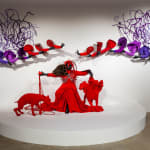Mary Sibande South Africa, b. 1982
400 x 250 x 300 cm
Further images
-
(View a larger image of thumbnail 1
)

-
(View a larger image of thumbnail 2
)

-
(View a larger image of thumbnail 3
)

-
(View a larger image of thumbnail 4
)

-
(View a larger image of thumbnail 5
)

-
(View a larger image of thumbnail 6
)

-
(View a larger image of thumbnail 7
)

-
(View a larger image of thumbnail 8
)

-
(View a larger image of thumbnail 9
)

-
(View a larger image of thumbnail 10
)

-
(View a larger image of thumbnail 11
)

-
(View a larger image of thumbnail 12
)

-
(View a larger image of thumbnail 13
)

-
(View a larger image of thumbnail 14
)

-
(View a larger image of thumbnail 15
)

-
(View a larger image of thumbnail 16
)

-
(View a larger image of thumbnail 17
)

-
(View a larger image of thumbnail 18
)

-
(View a larger image of thumbnail 19
)

-
(View a larger image of thumbnail 20
)

-
(View a larger image of thumbnail 21
)

-
(View a larger image of thumbnail 22
)

-
(View a larger image of thumbnail 23
)

-
(View a larger image of thumbnail 24
)

“This installation reflects on the legacy or the after taste of Apartheid in South Africa. The work is a pseudo psychological investigation, exploring a suppressed and yet ubiquitous emotion, that of anger. At the core of the work is the preservation of the heart. In isiZulu, and more broadly iNguni-speaking people, the heart is associated with a wide spectrum of emotions such as anger, impatience and tolerance. The color red has many metaphorical associations, from spiritual, to links with blood. According to a common Zulu expression, an angry person is defined as a “red dog”. The emotive quality of anger relegates the individual as belonging outside humanity and in the realm of animal. There is also a nihilistic approach to anger, in which the emotion of anger, as located in the heart, manifests destruction which includes the figure harboring it. These thematic concerns speak to the condition of the post-Apartheid dissatisfaction in contemporary South African society. The working title invokes a Tshivenda practice called the ‘Domba Dance’ (also called the ‘Python Dance’). Performed by young women, the dance symbolizes fertility and sexuality during their initiation ceremony as they transition into adulthood. In this case, the melodic movement conveys the passing on of the torch. ‘Sophie’ has now entered her red phase.”
Provenance
Artist studioKavi Gupta























